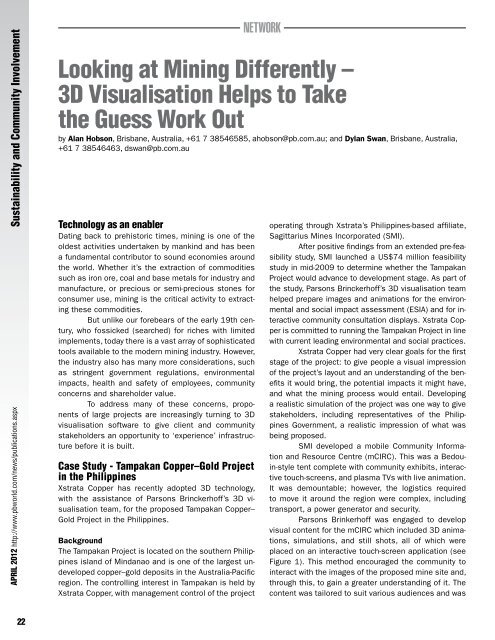Mining & Mined Caverns - Parsons Brinckerhoff
Mining & Mined Caverns - Parsons Brinckerhoff
Mining & Mined Caverns - Parsons Brinckerhoff
Create successful ePaper yourself
Turn your PDF publications into a flip-book with our unique Google optimized e-Paper software.
Sustainability and Community Involvement<br />
APRIL 2012 http://www.pbworld.com/news/publications.aspx<br />
22<br />
Technology as an enabler<br />
Dating back to prehistoric times, mining is one of the<br />
oldest activities undertaken by mankind and has been<br />
a fundamental contributor to sound economies around<br />
the world. Whether it’s the extraction of commodities<br />
such as iron ore, coal and base metals for industry and<br />
manufacture, or precious or semi-precious stones for<br />
consumer use, mining is the critical activity to extracting<br />
these commodities.<br />
But unlike our forebears of the early 19th century,<br />
who fossicked (searched) for riches with limited<br />
implements, today there is a vast array of sophisticated<br />
tools available to the modern mining industry. However,<br />
the industry also has many more considerations, such<br />
as stringent government regulations, environmental<br />
impacts, health and safety of employees, community<br />
concerns and shareholder value.<br />
To address many of these concerns, proponents<br />
of large projects are increasingly turning to 3D<br />
visualisation software to give client and community<br />
stakeholders an opportunity to ‘experience’ infrastructure<br />
before it is built.<br />
Case Study - Tampakan Copper–Gold Project<br />
in the Philippines<br />
Xstrata Copper has recently adopted 3D technology,<br />
with the assistance of <strong>Parsons</strong> <strong>Brinckerhoff</strong>’s 3D visualisation<br />
team, for the proposed Tampakan Copper–<br />
Gold Project in the Philippines.<br />
Background<br />
The Tampakan Project is located on the southern Philippines<br />
island of Mindanao and is one of the largest undeveloped<br />
copper–gold deposits in the Australia-Pacific<br />
region. The controlling interest in Tampakan is held by<br />
Xstrata Copper, with management control of the project<br />
Network<br />
Looking at <strong>Mining</strong> Differently –<br />
3D Visualisation Helps to Take<br />
the Guess Work Out<br />
by Alan Hobson, Brisbane, Australia, +61 7 38546585, ahobson@pb.com.au; and Dylan Swan, Brisbane, Australia,<br />
+61 7 38546463, dswan@pb.com.au<br />
operating through Xstrata’s Philippines-based affiliate,<br />
Sagittarius Mines Incorporated (SMI).<br />
After positive findings from an extended pre-feasibility<br />
study, SMI launched a US$74 million feasibility<br />
study in mid-2009 to determine whether the Tampakan<br />
Project would advance to development stage. As part of<br />
the study, <strong>Parsons</strong> <strong>Brinckerhoff</strong>’s 3D visualisation team<br />
helped prepare images and animations for the environmental<br />
and social impact assessment (ESIA) and for interactive<br />
community consultation displays. Xstrata Copper<br />
is committed to running the Tampakan Project in line<br />
with current leading environmental and social practices.<br />
Xstrata Copper had very clear goals for the first<br />
stage of the project: to give people a visual impression<br />
of the project’s layout and an understanding of the benefits<br />
it would bring, the potential impacts it might have,<br />
and what the mining process would entail. Developing<br />
a realistic simulation of the project was one way to give<br />
stakeholders, including representatives of the Philippines<br />
Government, a realistic impression of what was<br />
being proposed.<br />
SMI developed a mobile Community Information<br />
and Resource Centre (mCIRC). This was a Bedouin-style<br />
tent complete with community exhibits, interactive<br />
touch-screens, and plasma TVs with live animation.<br />
It was demountable; however, the logistics required<br />
to move it around the region were complex, including<br />
transport, a power generator and security.<br />
<strong>Parsons</strong> Brinkerhoff was engaged to develop<br />
visual content for the mCIRC which included 3D animations,<br />
simulations, and still shots, all of which were<br />
placed on an interactive touch-screen application (see<br />
Figure 1). This method encouraged the community to<br />
interact with the images of the proposed mine site and,<br />
through this, to gain a greater understanding of it. The<br />
content was tailored to suit various audiences and was

















